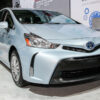In the trucking industry, innovation is key to improving efficiency, safety, and sustainability on the road. Over the years, countless new technologies and ideas have promised to change the game, but not all of them managed to take off. Some were too costly, others were unreliable, and a few just didn’t meet the practical needs of trucking companies and drivers. Here’s a look at 11 trucking innovations that, despite their initial promise, ultimately failed to gain traction in the industry.
Contents
Cabover Truck Designs

Cabover trucks, featuring a cab-over-engine layout, promised better maneuverability and more cargo space. Despite these advantages, the design made for cramped driver quarters and bumpy rides, especially on long hauls. As the trucking industry prioritized comfort and driver safety, conventional hooded trucks won out. Cabovers also struggled to meet safety standards in North America, even as they remained popular in Europe. Eventually, fleets moved away from cabover designs in favor of vehicles that maximized visibility and comfort.
Diesel-Hybrid Trucks

Diesel-hybrid trucks seemed like a natural step toward greener trucking, but they never took off. Although they offered some fuel savings, these trucks were costly to manufacture and didn’t perform as well under heavy loads. Many companies found that the fuel efficiency gains simply didn’t offset the high upfront cost. Additionally, hybrid engines introduced complex maintenance issues that proved burdensome. Today, diesel engines dominate, as they’re both cost-effective and increasingly efficient.
Automatic Transmission Trucks

Automatic transmissions were introduced to simplify driving and ease gear shifts in heavy-duty trucks. Yet, many drivers found that these transmissions performed poorly on steep grades and with heavy loads. Early models had high repair costs, and their initial reliability issues led companies to favor manual options. As a result, many fleets continued to choose manual transmissions for their durability and better control. Although improved versions are now available, they haven’t completely replaced manuals in the industry.
Driver Alertness Monitoring Systems

Driver alertness systems aimed to enhance safety by tracking signs of fatigue or distraction in real time. Yet, many drivers considered the technology invasive and uncomfortable, raising concerns about privacy. Additionally, the high cost of implementing these systems proved prohibitive for most companies. As more reliable and less intrusive safety options emerged, alertness monitoring lost favor. Today, technologies like lane departure warnings are more widely used to support driver safety.
Autonomous Trucking

Autonomous trucks promised to alleviate driver shortages and reduce labor costs across the industry. Despite the enthusiasm, technical challenges, high expenses, and regulatory issues stalled their progress. Safety concerns also dampened enthusiasm, especially with public opinion wary of self-driving technology. Moreover, long-haul routes posed unique difficulties that limited the technology’s effectiveness. Although research continues, autonomous trucks are still far from mainstream use.
Electric Long-Haul Trucks

Electric trucks initially generated excitement for their potential to reduce emissions, but the technology faced significant limitations. Heavy batteries limited payload capacity, while long charging times created logistical challenges for long-haul operations. Many companies found these drawbacks impractical compared to conventional diesel trucks. Furthermore, the scarcity of charging stations limited their feasibility. Electric trucks remain an area of innovation, but widespread adoption remains a distant goal.
Advanced Diesel Particulate Filters (DPF)

Advanced diesel particulate filters (DPF) were intended to meet emissions regulations but quickly became a headache for truckers. Many drivers experienced frequent clogging, leading to high maintenance and cleaning costs. DPFs also sometimes compromised fuel efficiency and engine performance, frustrating fleet managers. As a result, some operators chose to disable the technology entirely. Today, the trucking industry continues to look for alternatives that improve compliance without sacrificing performance.
Aerodynamic Trailer Skirts

Aerodynamic trailer skirts were introduced to reduce drag and improve fuel efficiency on highways. However, the skirts frequently sustained damage on rougher roads, leading to frequent repair costs. Companies soon found that the fuel savings were modest and often didn’t justify these expenses. Consequently, only a few fleets adopted the technology, primarily for long-haul routes with smoother terrain. For many, the benefits simply weren’t substantial enough.
Low-Rolling Resistance Tires

Low-rolling resistance tires promised fuel savings by reducing friction, but they wore down faster than standard tires. For trucking companies, this increased replacement costs, making the tires an expensive choice for long-haul routes. Drivers also reported that the tires offered less traction, which proved problematic in wet or icy conditions. This diminished their appeal, especially in regions with severe weather. Many fleets ultimately reverted to traditional tire options.
Compressed Air-Powered Brakes

Compressed air-powered braking systems aimed to improve reliability while eliminating hydraulic fluid use. However, the systems required specialized maintenance, and their performance was inconsistent in extreme temperatures. Companies found that the high installation costs and potential operational failures limited their practicality. As a result, hydraulic braking systems remained the norm across the industry. Compressed air systems faded into obscurity as fleets prioritized more proven technology.
Modular Truck Cabins

Modular truck cabins allowed for custom configurations, offering flexibility for drivers and companies alike. Despite this adaptability, the complex designs and high costs dissuaded many companies from investing in the technology. Many drivers found that standard cab setups met their needs more effectively without added expenses. Consequently, modular cabins failed to deliver a significant advantage over traditional layouts. Today, manufacturers focus on refining traditional cab designs to optimize comfort and usability.
This article originally appeared in MyCarMakesNoise.
More from MyCarMakesNoise
15 Unexpected RV Features That Make Travel Easier

RVs have come a long way from just being mobile homes on wheels. Today’s RVs are packed with features that can surprise even the most seasoned travelers. From hidden storage solutions to high-tech gadgets, these 15 surprising RV features will make you rethink what’s possible on the road. Read More.
17 Underappreciated Military Aircraft That Played Crucial Roles

Many military aircraft have earned legendary status, but some crucial models never got the recognition they deserved. These underappreciated planes played vital roles in conflicts, often making the difference in key operations. Read More.
19 Vintage Airplanes That Have Lost Their Market Value

Over time, even the most iconic vintage airplanes can lose their market value. As technology advances and newer models take over, many older aircraft become less practical and too costly to maintain. Read More.














